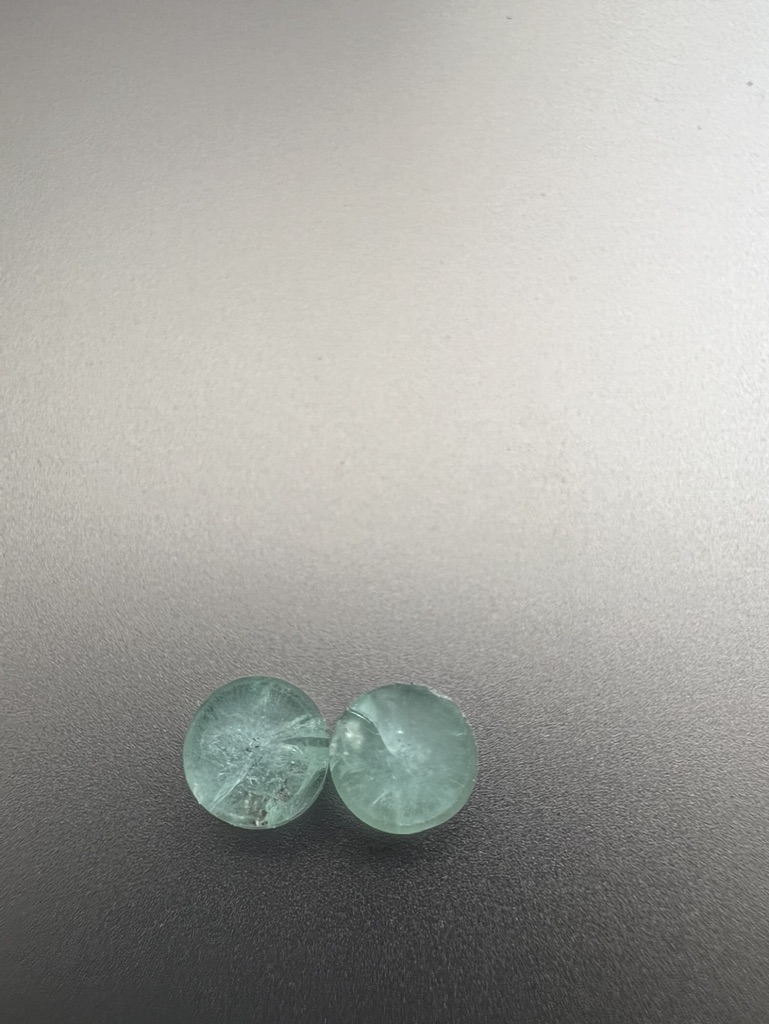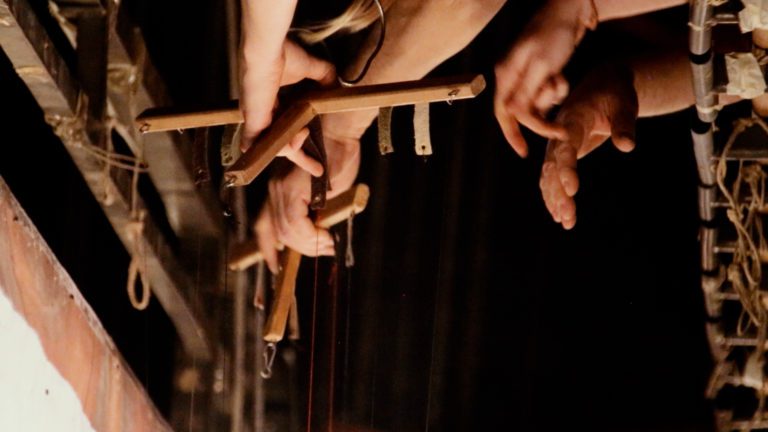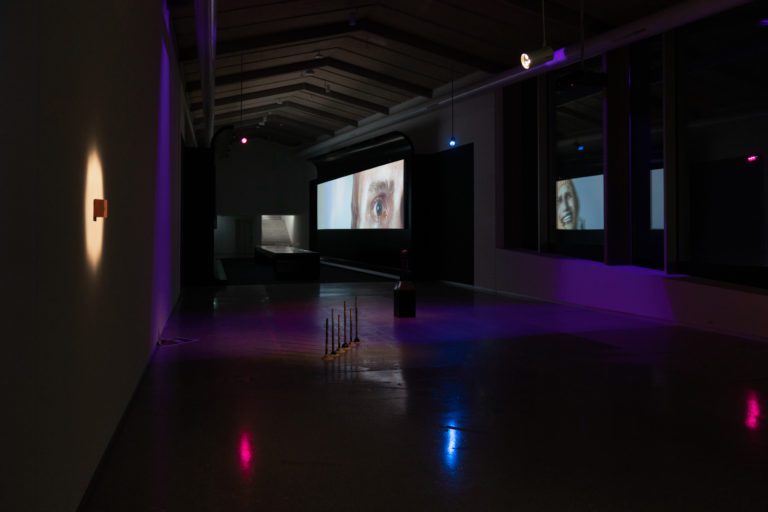Starting in the spring of 2022, EPFL hosted four artistic residencies. Each artist worked closely with one or more EPFL laboratories to create a project, which was exhibited at the EPFL Pavilions in early 2023.
Here, each artist takes us on a journey through the process of answering their questions, using a unique combination of methods that blurs the line between artistic and scientific inquiry.
An olivine exoplanet rendered by Midjourney AI that Kuennen used to explore the first phase of the Spheroids project. © Joel Kuennen, Spheroids, 2023
What is the role of exoplanets in our cultural imaginary?
Joel Kuennen : Spheroids
You may have never heard of olivine, but you encounter it every day: the magnesium iron silicate is one of the most common minerals in the world, and a primary component of the Earth’s mantle. Its carbon sequestration and tectonic properties make it ideal for supporting life on this planet…and possibly those beyond our solar system.
“There is just something about olivine that held my attention. It’s a beautiful green crystal, which in gemstone form we know as peridot. But when I came across a paper in the European Journal of Minerology that mentioned it makes up the vast majority of interstellar dust, it all just clicked. It’s interesting when your intuition leads to something more nuanced than you expected,” reflects Joel Kuennen.
The US-based artist developed a project, Spheroids, around the question of how we think of exoplanets in the context of our own earthly existence, and the threats to it that we face today.
“Elon Musk and Jeff Bezos are spending billions to expand an extractive, neocolonial enterprise into space, when they could be using this money to rethink systems of equity and support here on Earth,” Kuennen says. “How should we view space in an age of commercial exploration and exploitation, while simultaneously facing a planet-wide climate crisis?
To stimulate introspection and debate on these uncomfortable questions, Kuennen developed Object of Interest 700 e as an installation that simultaneously attracts and repels viewers. They landed on the idea of investigating olivine following conversations with Claudio Grimaldi and Paolo de los Rios in the Laboratory of Statistical Biophysics (LBS) regarding abiogenesis, the process of creating life from non-living matter like simple organic compounds, and the conditions necessary to support extraterrestrial life.
Kuennen then worked with Yong Liu and Arnaud Magrez at the Crystal Growth Facility to grow seven single olivine crystals using infrared lasers. Crystals are usually grown starting with a seed crystal, but Kuennen wanted instead to grow crystals from a natural mineral in order to realize the colours of nature from yellow green to deep green in the lab. The use of the natural mineral as the source for the crystals led Liu to develop a novel method to grow them, a laser-heated floating-zone technique, which Kuennen, Liu, and Magrez will present in the summer of 2023 at the International Conference on Crystal Growth and Epitaxy.
Kuennen also mined the mineral for sound in order to “hear the time of Earth”. Quartz crystal oscillators are used in most modern timekeeping devices like smartphones and watches. Using one of the crystals grown in the lab, Kuennen found the resonating frequency of the crystal and used a thin slice of it to build a crystal oscillator with the Earth-defining mineral.
Our cultural imaginary around exoplanets is still fluid, meaning we still have a choice about how we think about it.”

Joel Kuennen © Riccardo Banfi
“Our cultural imaginary around exoplanets is still fluid, meaning we still have a choice about how we think about it. The point of my work is to invite people to think in terms of longer timeframes, and to extract ourselves from the persistent present demanded by our media sphere.”
Kuennen produced a porcelain “spheroid” shrouded in layers of biofilm made from fungi and bacteria that are symbiotic to human digestion. This spheroid rests above a ceramic basin, which was cast using clay that they collected from Le Grammont near Vouvry – the mountainous site of an ancient landslide that triggered a tsunami that devastated Geneva in the year 563 ACE.
For Kuennen, the integration of the clay is a nod to humanity’s history of disaster, as well as a warning of the potentially disastrous outcome of space colonization; a warning that invites us to rethink our conception of alien worlds as ripe for our exploitation and profit.
“I have begun to understand that life, throughout the cosmos, is inevitable. The same chemical processes from which life developed on Earth are at work throughout the universe. The universe isn’t an exotic place ripe for touristic travel, but one that is radically familiar and deserving of care.”

Two olivine discs cut from crystal used for the crystal oscillator. © Joel Kuennen

How do you define a robot?
Riccardo Giacconi: Rational and Irrational Numbers
The project of IUAV University of Venezia fine arts graduate Riccardo Giacconi zooms in from celestial bodies to the human body. He kicked off his residency with two weeks of interviews with researchers in EPFL’s Reconfigurable Robotics Lab (RRL), Biorobotics Laboratory (BioRob), and Learning Algorithms and Systems Laboratory (LASA), to explore artistic and scientific questions at the boundary between human and machine.
During the interviews, Giacconi was surprised at the wide range of answers to his questions from researchers in different areas of artificial intelligence and robotics, and at how closely these responses related to his own interest in animation through puppetry.
“One researcher said that a robot is ‘an intelligent machine that does physical work,’ with intelligence being defined as ‘the ability to react to information received about its environment,’ Giacconi says. “Another definition I found interesting is that a robot is ‘a placeholder for a living being’. This is connected to my work with marionettes and animation – giving objects an appearance of life.”
Giacconi also received varying responses to his inquiries about robotic ethics (who should have first access to these technologies?) and forms (are humanoid robots still a useful concept, or does the future belong to foldable Moris and amphibious Pleurobots?) But throughout his questioning, a common theme emerged: robotics is as much a study of humans as it is of machines.
“Robotics deals with how we conceive of ourselves as humans, and how we perceive the world. That has been a radical shift of perspective for me. From different conversations came the idea of robotics defining a spectrum, with autonomous machines at one end, and integrated technologies like ‘human augmentation’ at the other.”
This realization led Giacconi to imagine the place of puppets along such a spectrum, which in turn inspired his AiR project. Based on his interviews and footage of the EPFL labs, Giacconi is developing a narrative film, featuring robots as well as puppets, in collaboration with the Milan-based Carlo Colla & Figli Puppet Company.

Footage of the Carlo Colla & Figli Puppet Company taken by Giacconi. © Riccardo Giacconi, Animal, 2023
His project title, Rational and Irrational Numbers, references the spark of magic that Giacconi sees at the heart of animation, whether of a puppet or robot. He is interested in the relationship between the animator and the animated, which in the context of puppetry he defines as a two-way dance: every puppeteer needs to leave empty space in their practice to indulge the marionette’s autonomy.
This is connected to my work with marionettes and animation – giving objects an appearance of life.”

Riccardo Giacconi © Marc Delachaux
“I use irrational numbers as a metaphor for this phenomenon, known in the arts as ‘aura’, because animation is something that happens through a leap of faith: we know these objects are not alive, but we suspend our disbelief,” Giacconi explains. “Even for the researchers I spoke with, seeing their robot suddenly come to life can still spark surprise and a sense of joy.”

How can we understand the self in relation to the environment?
Dorota Gawęda and Eglė Kulbokaitė: Synthetic Landscapes
The project of Dorota Gawęda and Eglė Kulbokaitė considers synthetic landscapes. Originally from Poland and Lithuania, respectively, the artists now reside in Basel, where their multimedia practice draws on extensive historical and theoretical research processes.
“We like to combine things that seem to be opposites, like technology and mythology, and to use specific characters and situations as a trigger for a narrative that gradually becomes less specific and more abstract,” Gawęda explains. In the case of their AiR project, entitled Synthetic Landscapes, the artists bring together a data-driven film, artificial intelligence, and elements of Eastern European folk stories and fables
Gawęda and Kulbokaitė explore the conceptualization of the self as being distinct from nature, and to critically address the role that artists and scientists have played in this alienation through the use of technology, photography, or painting. Through this research, they aim to challenge the ‘illusory’ concept of the self as being separate from the environment in order to negotiate new ways of relating to the world.

Dorota Gawęda and Eglė Kulbokaitė, Mouthless Part III (Panorama) exhibition presented in conjunction with Joel Kuennen’s Object of Interest 700 e, in February 2023 at EPFL Pavilions Pavilion A.© EPFL ETHS; photo: Riccardo Banfi.
To achieve this questioning, the duo developed a film entitled Mouthless Part III; the third instalment in a series of works dealing with the environment and language we use to describe it. The film was developed in collaboration with the EPFL Center for Imaging, and inspired by exchanges with CLIMACT, and combined data on extreme weather events with GAN (generative adversarial network) simulations to create a backdrop of artificial landscapes with climates that shift and change.
Gawęda and Kulbokaitė worked with with the Imaging Center team, including Laurène Donati, Edward Andò, and Florian Aymanns to identify and develop algorithms that could be used to generate a visual output of various landscapes and weather conditions. They then used their own images and text input commands to build an ever-shifting environment for their film’s characters to ‘live’ in.
In their video, these characters – a peasant and a demon from Slavic folklore, which are both portrayed by the same actor – engage in an evolving dialogue against this meteorological backdrop. The changing environment influences their interactions, just as extreme weather events – whether due to an ice age or the current climate crisis – have shaped human societies since their inception.
“A year without summer or a volcanic eruption can trigger social events like hunger or revolution; in a similar way, the conversation in the film shifts and changes,” Kulbokaitė says.
The duo’s AiR project is rich with environmental, social, and existential messaging, but when it comes to the experience of the completed work, they hope that viewers will draw their own conclusions.
“We want to explore the artist’s role in telling stories about the self and our relationship to the earth, and the idea that the self outside of nature is an illusion,” Gawęda says. “We are trying to say all these things as artists, but we believe that whatever people take away from the film is valuable. We hope it makes them think and feel differently.”
We want to explore the artist’s role in telling stories about the self and our relationship to the earth, and the idea that the self outside of nature is an illusion.”
Dorota Gawęda
What separates the animate from the inanimate?
Alan Bogana: Light-Oriented Ontologies
Swiss visual artist Alan Bogana created a multimedia project, Light-Oriented Ontologies, which explores interactions between light and matter using scientific techniques, such as holography and volumetric 3D printing. His project can currently be seen as part of the new exhibition at EPFL Pavilions, Lighten Up! On Biology and Time.
While it may seem like a light-and-imaging based project would be easily suited to artistic media, Bogana explains that it was in fact be a considerable challenge to apply techniques adapted to the micro and nanoscale to an exhibition-scale work of art. But the Geneva-based artist has built a practice focused on the relationships between science, technology, culture, and perception, and had prior experience working with scientists and lab techniques, including a residency at CERN.
It is therefore fitting that he launched his AiR project with an extensive immersive research phase on the EPFL campus. This included meetings and in-depth discussions with researchers, notably from the Laboratory of Applied Photonics Devices (LAPD) and the Optics Laboratory.
“I think that a common aspect of art and science is the relationship to the unknown and how we deal with it; what kinds of questions we ask ourselves,” Bogana says. “I really wanted to get a sense of the scientists’ work, to understand their area of specialization and where it is going, what their research questions are, and what the ‘holy grail’ of their domain is.”
Alan Bogana’s process for creating the 3D printed resin from light patterns. © Alan Bogana, Light-Oriented Ontologies — The Beginnings, 2023 (video excerpt courtesy of the artist)
From these discussions, Bogana identified a number of interesting themes and techniques, but focused his project on the use of volumetric 3D printing to produce in-vitro biological tissues called organoids. Unlike layer-by-layer 3D printing, the volumetric 3D printing method being developed by Christophe Moser and colleagues in the LAPD involves illuminating a photosensitive resin from different angles. The pattern of light projected at the resin causes it to polymerize, or harden, into a given shape, which can take smooth or curved forms that are difficult to achieve with traditional 3D printing. This makes it an ideal technique for producing in-vitro organs and tissues for medical research, for example.
“One of the central aspects of this research is the threshold between the living and nonliving,” Bogana says. “I am interested in zooming in on certain artifacts that humans are creating, and then studying how they behave and interact at different scales to see what kinds of narratives emerge”. For example, what kinds of ethical questions or narratives might the volumetric 3D printing of organs evoke? To what extent does light itself have agency, or even a consciousness?
These techniques and questions inspired the installation “Light-Oriented Ontologies – The Beginnings”, which is part of the ongoing “Lighten Up!” exhibition. The work reflects on the earliest roots of vision, sensing, and converting light into energy and information. How did sensitivity to light evolve and shape ancestral life on Earth? How can we understand our relationship to light by looking back at the evolutionary roots of this relationship?
The installation consists of an ensemble of translucent objects, which are direct solidifications of light propagating through photosensitive resin. They are crystallized light beams stemming from the interactions with different types of optical components and spatial movements generated by motors and manual manipulations. These objects create an ensemble of shapes, ambiguously reminiscent of simple living organisms, unlikely organs of vision and organic-looking inorganic structures found in nature, such as fossils.
“I think that a common aspect of art and science is the relationship to the unknown and how we deal with it; what kinds of questions we ask ourselves.”

Alan Bogana © Patrick Nedel
About the CDH-AiR program
Initiated by the College of Humanities and amplified by EPFL Pavilions Enter the Hyper-Scientific reflects the CDH’s mission of fostering transdisciplinary encounters between artists and the scientific community at EPFL. By forging collaborations between artists and scientists in different disciplines, the program aims to establish a platform for propelling new approaches and aesthetic investigations at the intersection of art, technology, science, and the humanities.
Since 2022 the program is in partnership with the City of Lausanne which offers resident artists accommodation in the newly inaugurated housing cooperative La Meute, where various cultural practitioners and artists reside, allowing an exchange with the rich Lausanne cultural scene.
Exhibition schedule
Current:
Presentation Alan Bogana 24 March – 30 July 2023 – Lighten Up! On Biology and Time EPFL Pavilions Pavilion B
Past:
Exhibition Riccardo Giacconi 12 – 29 January 2023 – EPFL Pavilions Pavilion A
Exhibition Joel Kuennen + Dorota Gaweda/Eglė Kulbokaite 2 – 26 February 2023 – EPFL Pavilions Pavilion A